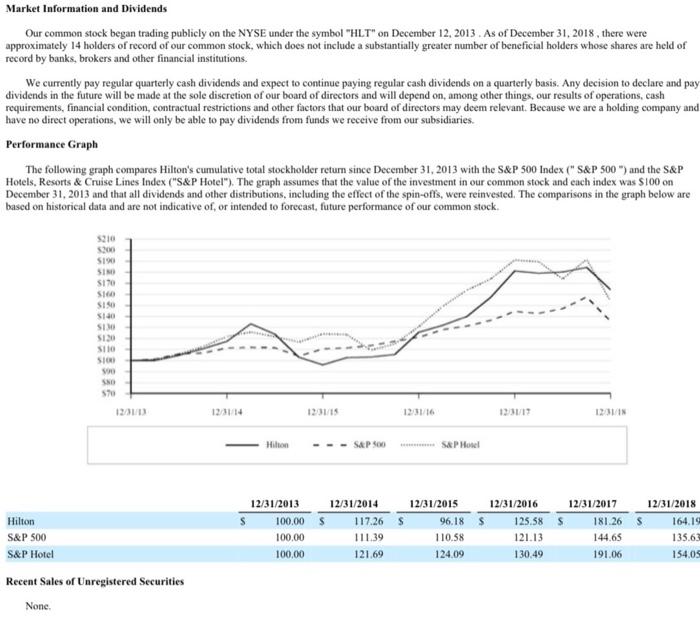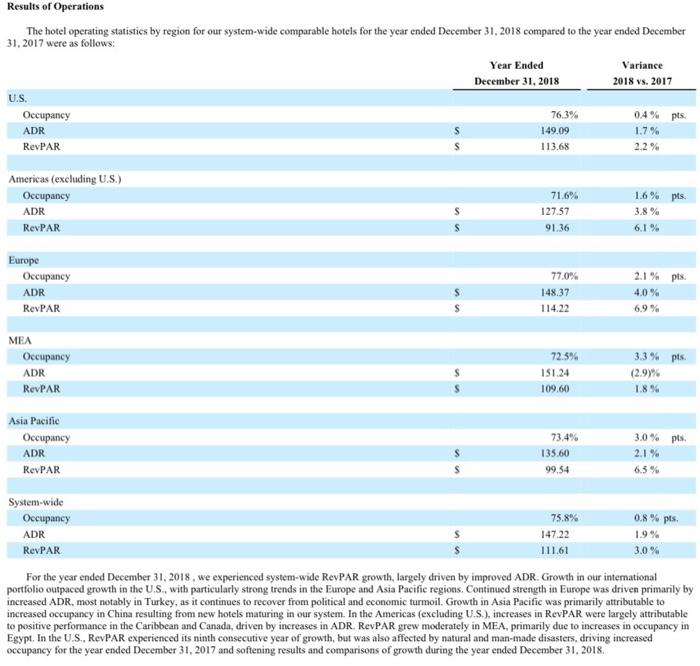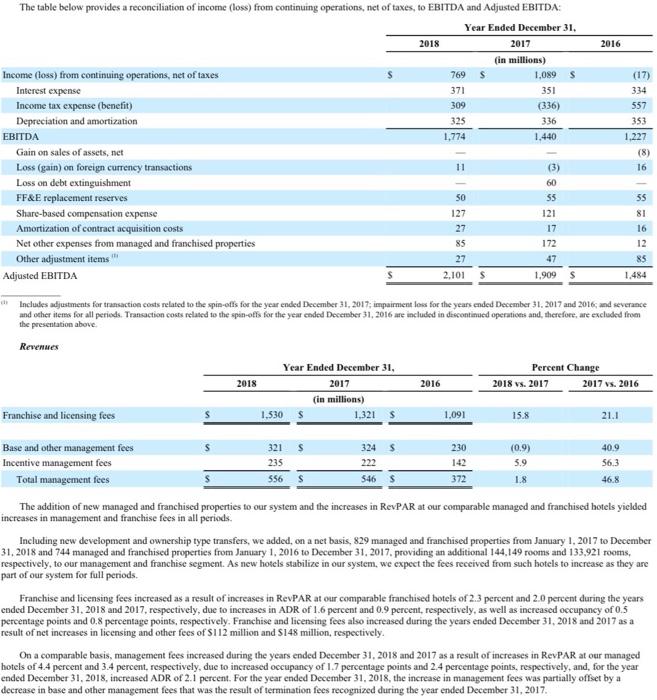Using the Hilton Report.pdf
1a. What is the Current Ratio of Hilton in 2018? If the upper quartile, median, and lower quartile for this ratio in the hotel industry are 1.7, 0.9, and 0.6 respectively, how would you characterize the liquidity of Hilton? What is the Total Assets Turnover ratio of Hilton in 2018?
1b. If the upper quartile, median, and lower quartile for this ratio in the hotel industry are 0.7, 0.4, and 0.3 respectively, how would you characterize the ability of Hilton in utilizing its assets? TIE is an important solvency ratio. Given the upper quartile, median, and lower quartile for this ratio in the hotel industry are 3.1, 2.0, and 0.9, comment on Hilton's solvency status for 2018.
Market Information and Dividends Our common stock began trading publicly on the NYSE under the symbol "HLT" on December 12, 2013. As of December 31, 2018, there were approximately 14 holders of record of our common stock, which does not include a substantially greater number of beneficial holders whose shares are held of record by banks, brokers and other financial institutions. We currently pay regular quarterly cash dividends and expect to continue paying regular cash dividends on a quarterly basis. Any decision to declare and pay dividends in the future will be made at the sole discretion of our board of directors and will depend on, among other things, our results of operations, cash requirements, financial condition, contractual restrictions and other factors that our board of directors may deem relevant. Because we are a holding company and have no direct operations, we will only be able to pay dividends from funds we receive from our subsidiaries. Performance Graph The following graph compares Hilton's cumulative total stockholder return since December 31, 2013 with the S\&P 500 Index (" S\&P 500 ") and the S\&P Hotels, Resorts \& Cruise Lines Index ("S\&P Hotel"). The graph assumes that the value of the investment in our common stock and each index was $100 on December 31, 2013 and that all dividends and other distributions, including the effect of the spin-offs, were reinvested. The comparisons in the graph below are based on historical data and are not indicative of, or intended to forecast, future performance of our common stock. Recent Sales of Unregistered Securities None. Issuer Purchases of Equity Securities The following table sets forth information regarding our purchases of shares of our common stock during the three months ended December 31,2018 : The total namber of shares purchased includes 102.045 shares of commen stock acquired for a total cost of approvimately 57 million that were not part of any publicly announced repurchase program. These shares were retained to cever withbolding tases incurred in connection with the vesting of restricted stexk awards granted under our incentive consensation plans. This price includes per share commissions paid. In February 2017, eur board of directors authorized a stock reporchase program of up to $1.0 billion of the Company's commen stock and, in November 2017 , as additional \$1.0 billien was authorised. Under this publicly announced program, the Company is authorized to reparchase shares through open market purchases, privately-negotiated transactions or otherwise in accoflance with applicable federal securities lows, including through Rule lobs-1 trading plans and under Rule tob-I8 of the Exelange Act. The repurchase program dees not have an expiration date and may be suspended or discontinued at any time. We derived the selected statement of operations data for the years ended December 31, 2018, 2017 and 2016 and the selected balance sheet data as of December 31, 2018 and 2017 from our asdited consolidated financial statements included elsewbere in this Annual Report on Form 10-K. All selected financial data as of and for the years ended December 31,2017 and 2016 have been restated to reflect the adoption of Accounting Standards Update ("ASU") No. 2014-09, Revenue from Contracts with Customers (Topic 606) ("ASU 2014-09") using the full retrospective approach as of January 1, 2016. The selected balance sheet data as of December 31, 2016 was derived from unaudited consolidated financial statements that are not included in this Annual Report on Form 10-K and reflect the adoption of ASU 2014-09. The selected statement of operations data for the years ended December 31, 2015 and 2014 and the selected balance sheet data as of December 31, 2015 were derived from audited consolidated financial statements that are not included in this Annual Report on Form 10 - K and have not been adjusted from the basis of accounting applied before our adoption of ASU 2014-09. The selected balance sheet data as of December 31 , 2014 was derived from unaudited consolidated financial statements that are not included in this Annual Report on Form 10 - K and have not been adjusted from the basis of accounting applicd before our adoption of ASU 2014-09. The selected financial data below should be read together with the consolidated financial statements including the related notes thereto and "Part II-Item 7. Management's Discussion and Analysis of Financial Condition and Results of Operations" included elsewhere in this Annual Report on Form 10-K. Our historical results are not necessarily indicative of the results expected for any future period. The hotel operating statistics by region for our system-wide comparable hotels for the year ended December 31,2018 compared to the year ended December 31. 2017 were as follows: For the year ended December 31, 2018, we experienced system-wide RevPAR growth, largely driven by improved ADR. Growth in our international portfolio outpaced growth in the U.S., with particularly strong trends in the Europe and Asia Pacific regions. Continued strength in Europe was driven primarily by increased ADR, most notably in Turkey, as it continues to recover from political and economic turmoil. Growth in Asia Pacific was primarily attributable to increased occupancy in China resulting from new hotels maturing in our system. In the Americas (excluding U.S.), increases in RevPAR were largely attributable to positive performance in the Caribbean and Canada, driven by increases in ADR. RevPAR grew moderately in MEA, primarily due to increases in occupancy in Egypt. In the U.S., RevPAR experienced its ninth consecutive year of growth, but was also affected by natural and man-made disasters, driving increased occupancy for the year ended December 31,2017 and softening results and comparisons of growth during the year ended December 31,2018 . ai Includes adjustments for transaction costs related to the spis-offs for the year ended December 31, 2017; impairment loss for the years ended December 31 . 2017 and 2016; and severance and ocher iteres for all perieds. Transaction costs relased to the spin-otfs for the year caded Decereber 31, 2016 afe included in decentinued operaticess and, therefoec, are excluded from the presentation above. Revenues The addition of new managed and franchised properties to our system and the increases in RevPAR at our comparable managed and franchised botels yiclded increases in management and franchise fees in all periods. Including new development and ownership type transfers, we added, on a net basis, 829 managed and franchised properties from January 1.2017 to December 31, 2018 and 744 managed and franchised properties from January 1, 2016 to December 31, 2017, providing an additional 144,149 rooms and 133,921 rooms, respectively, to our management and franchise segment. As new hotels stabilize in our system, we expect the fees received from such botels to increase as they are part of our system for full periods. Franchise and licensing fees increased as a result of increases in RevPAR at our comparable franchised hotels of 2.3 percent and 2.0 pereent during the years ended December 31, 2018 and 2017, respectively, due to increases in ADR of 1.6 percent and 0.9 percent, respectively, as well as increased oecupancy of 0.5 percentage points and 0.8 percentage points, respectively. Franchise and licensing fees also increased during the years ended December 31,2018 and 2017 as a result of net increases in licensing and other fees of $112 million and $148 million, respectively. On a comparable basis, management fees increased during the years ended December 31, 2018 and 2017 as a result of increases in RevPAR at our managed hotels of 4.4 pereent and 3.4 percent, respectively, due to increased occupancy of 1.7 percentage points and 2.4 pereentage points, respectively, and, for the year ended December 31, 2018, increased ADR of 2.1 percent. For the year ended December 31. 2018, the increase in management fees was partially offet by a decrease in base and other management fees that was the result of termination fees recognized during the year ended December 31 , 2017











